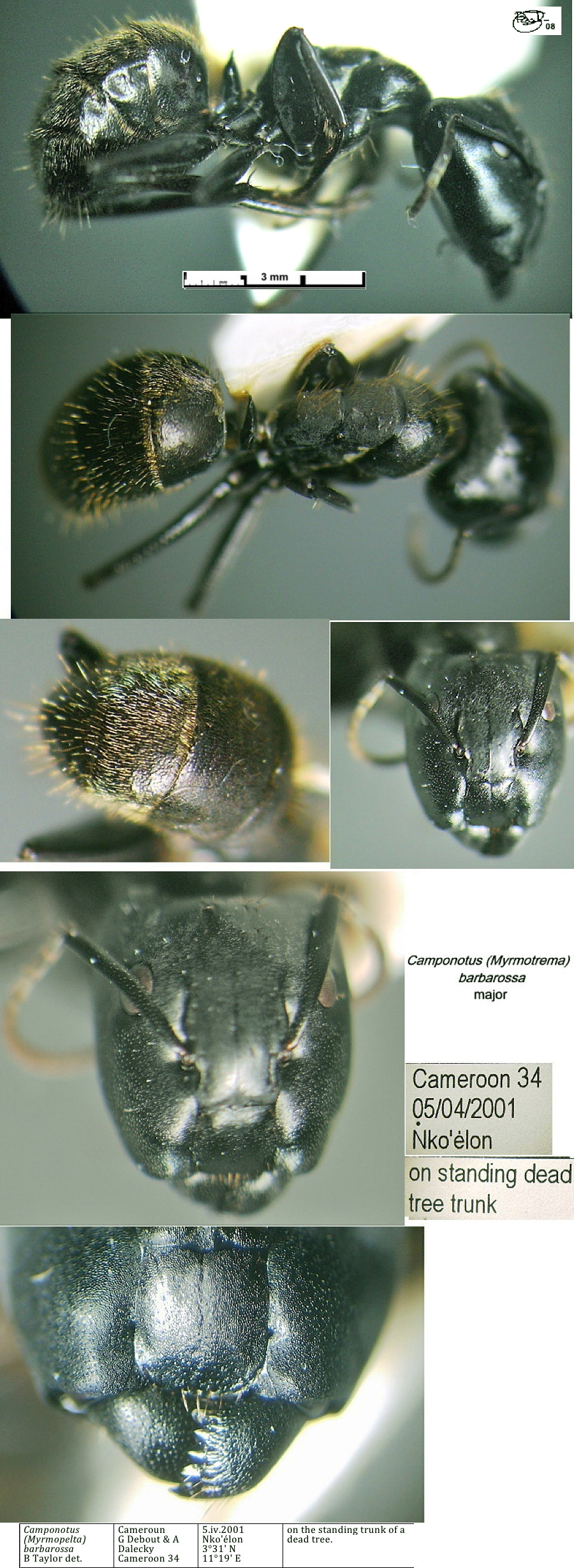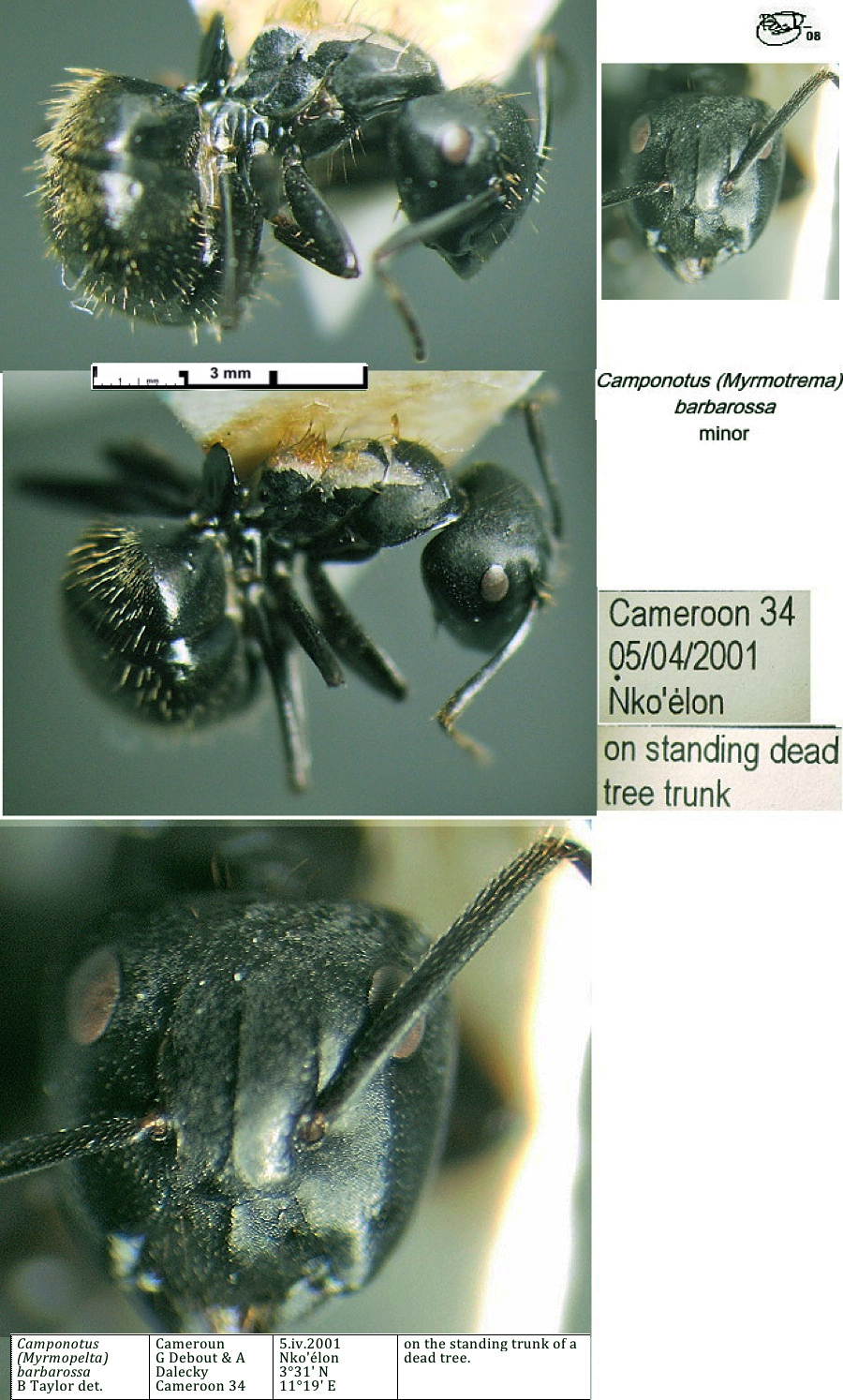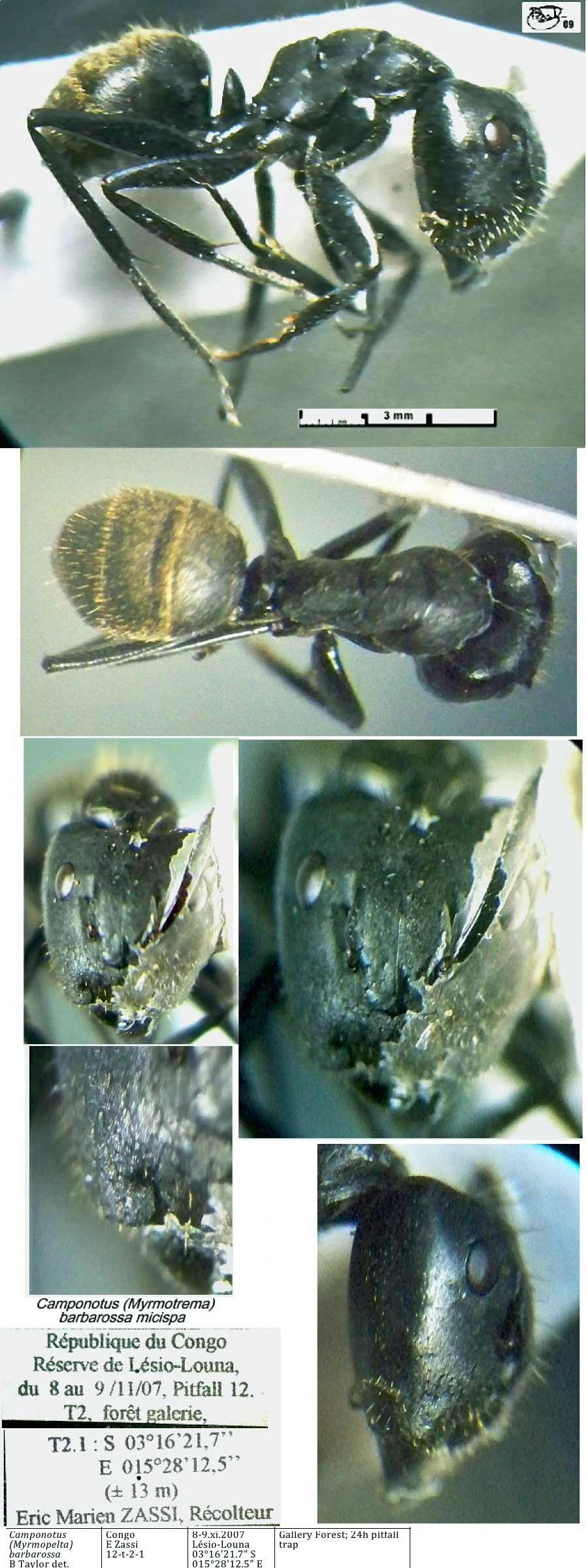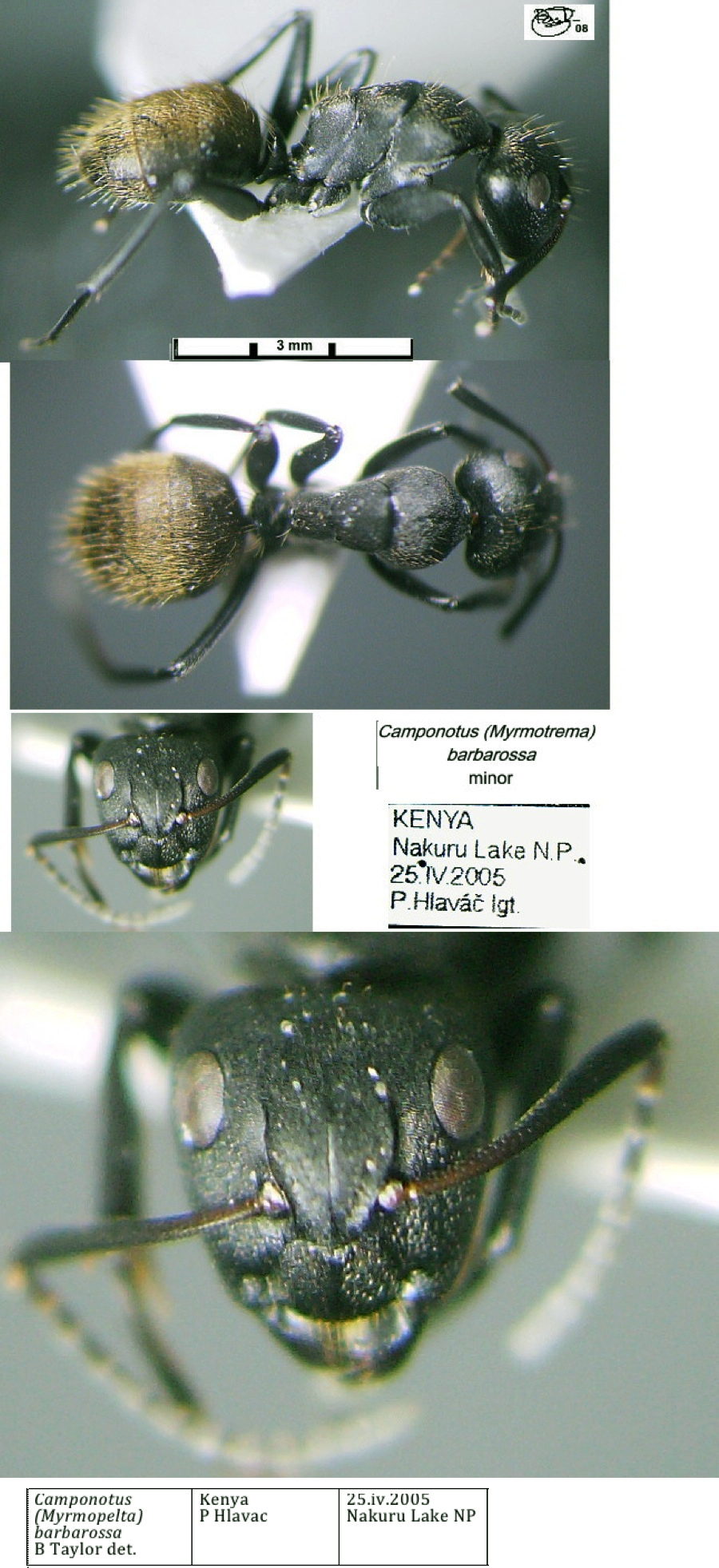Camponotus (Myrmopelta) barbarossa Emery
  Type location Cameroun
(Camponotus (Orthonotomyrmex) arminius subsp. barbarossa,
Emery, 1920c: 26, major & minor workers, and queen; named as species by Santschi, 1926a) Conradt - see
below Type location Cameroun
(Camponotus (Orthonotomyrmex) arminius subsp. barbarossa,
Emery, 1920c: 26, major & minor workers, and queen; named as species by Santschi, 1926a) Conradt - see
below
subspecies
micipsa (Wheeler, 1922: 252, illustrated major &
minor workers) from Zaïre, Leopold-Yumbi, Lang & Chapin -
see below; no images on Antweb (January 2019)
sulcatinasis (Camponotus
(Myrmopelta) babarossa
Em. v. sulcatinasis, nov.,
Santschi, 1926a: 21, worker) from Zaïre, Haut Uele, Burgeon -
see http://www.antweb.org/specimenImages.do?code=casent0911748
(see Bolton, 1995).
Note the name was first used as Camponotus barbarossa by
Forel (1910e: 457 - "Camponotus Barbarossa Emery subsp Arminius"
- & 1912i: 92 - listed as one of the species in his new subgenus Myrmotarsus)
which Bolton (1995: 88) has as nomina nuda but gave the odd
situation of Camponotus
arminius first being described as a ssp of barbarossa
which later appears, as above, as a ssp of arminius  . .
Emery's (1920c) description is at  . Santschi (1926a) summarised the species
and subspecies description, these are at . Santschi (1926a) summarised the species
and subspecies description, these are at  . .
|
 Nigeria
specimens (as Camponotus micispa
correct spelling micipsa, Wheeler, 1922, in Taylor, 1978: 9). Nigeria
specimens (as Camponotus micispa
correct spelling micipsa, Wheeler, 1922, in Taylor, 1978: 9).
MAJOR WORKER. TL 9.38 mm, HL 2.91, HW 2.79, SL 1.65, PW 1.71
Minor worker - none seen.
Colour black, shiny. Coarse erect hairs golden and long, abundant
except on head. Pilosity sparse on head, moderately dense on dorsum of
alitrunk, dense on gaster where it gives a golden pubescence. Declivity
of propodeum obtusely angled, metanotal groove incised. Petiole a thick
scale with the dorsal edge feebly notched in the middle.
A single specimen which corresponded very closely to Wheeler's (1922)
description of the species was collected foraging on cocoa at Gbodo,
near Ilesha.
I have to presume this may be the species spelt as barbarus
in the reports by Adjei and Firempong, see below. An alternative is the
species Camponotus barbaricus (Emery) of Spain and North Africa,
which Bolton (1995) noted as misspelt barbarus by Santschi in
a report of North African ants. Wheeler (1922) mentioned barbarossa
only as a species of which the definitive (1922)
species Camponotus (Orthonotomyrmex) arminius had earlier been
given as a subspecies; viz. - Camponotus barbarossa ssp arminius
and Camponotus barbarossa ssp arminius var
bicontractus, both, however, were from southern
Africa. See Camponotus
chrysurus
Santschi (1926a) gave several Zaïre locations including
Haut Uele, Moto; Ituri, La Moto (workers, by Burgeon); Vieux Cassongo,
Kimpako (Vanderijst); and Lesse (Lt. Bonnevie).
In Ghana, reported from CRIG by Adjei (1975) and
described as having a facultative association with the black citrus
aphid, Toxoptera aurantii, by Firempong (1975).
|
 The
photomontage of a major worker from the type collection is collated
from http://www.antweb.org/specimen.do?name=casent0905444. The
photomontage of a major worker from the type collection is collated
from http://www.antweb.org/specimen.do?name=casent0905444.
Emery gave the major head dimensions as HL 3.5 HW 3.1
mm; this has HL 2.3 HW 2.2
|
Oxford University Museum
specimens
|
 The photomontages
are of a major worker collected in Cameroun
- south-western tropical coastal forest area between Edéa and Campo
(McKey Wolbachia project) - Cameroon 34 from location Nko'élon
(3°31' N 11°19' E, altitude 452 m), 5 April 2001; on the standing trunk
of a dead tree. The photomontages
are of a major worker collected in Cameroun
- south-western tropical coastal forest area between Edéa and Campo
(McKey Wolbachia project) - Cameroon 34 from location Nko'élon
(3°31' N 11°19' E, altitude 452 m), 5 April 2001; on the standing trunk
of a dead tree.
|
 I surmise that the
specimens described as "Camponotus
sp. (large societies, medium sized worker with gaster covered by yellow
hairs" by Dejean, Belin and McKey (1992) may be of this species. They
found it on the canopy and midtrunk of 23 of 167 primary forest trees;
a non-dominant tolerated by Crematogaster depressa and nesting
in hollow branches or under bark (see also, Dejean et al.,
2000a). I surmise that the
specimens described as "Camponotus
sp. (large societies, medium sized worker with gaster covered by yellow
hairs" by Dejean, Belin and McKey (1992) may be of this species. They
found it on the canopy and midtrunk of 23 of 167 primary forest trees;
a non-dominant tolerated by Crematogaster depressa and nesting
in hollow branches or under bark (see also, Dejean et al.,
2000a).
|
 The
ssp micipsa (Wheeler, 1922) was described from 3 majors (TL
9-10 mm) and one media (TL 7.5) found on firewood aboard a river boat.
The description is as follows - The
ssp micipsa (Wheeler, 1922) was described from 3 majors (TL
9-10 mm) and one media (TL 7.5) found on firewood aboard a river boat.
The description is as follows -
|
|
 WORKER MAJOR - length 9 to 10 mm. Head large, longer than
broad (without the mandibles, 3,8 X 3 mm.), broader behind than in
front, with excised posterior border and evenly and very feebly convex
sides. Mandibles very convex, with 6 short, subequal teeth. Clypeus
rather flat, longer than broad, ecarinate and feebly longitudinally
grooved in the middle, subhexagonal, narrower in front than behind, its
anterior border somewhat truncated, straight. Frontal area impressed,
lozenge-shaped; frontal carinae widely separated, as far apart as their
distance from the sides of the head. Antennal scapes distinctly
flattened but not dilated, somewhat narrower at their tips than in perrisii,
extending a little beyond the posterior corners of the head. Eyes
rather small and flat. Promesonotal and metanotal sutures more
impressed than in perrisii; the propodeum somewhat cuboidal, as
long as broad, the base and declivity subequal, nearly rectangular in
profile, the former flattened, the latter very feebly concave, both
slightly submarginate on the sides. Petiole similar to that of perrisii
but broader above, the upper margin feebly notched in the middle. Hind
tibiae somewhat flattened but neither prismatic nor channelled, their
flexor borders without a row of bristles. Mandibles, clypeus, upper
surface of head, thorax, and gaster opaque; mandibular teeth, frontal
area, antennal scapes, gula, sides of thorax, posterior surface of
petiole, legs, and venter shining. Mandibles finely punctate on a very
finely and evenly shagreened ground. Head very finely, densely and
evenly punctate; the clypeus and cheeks with coarse, shallow, rather
sparse, piligerous foveolate, which are elongate and oblique, with
their posterior edges more pronounced. Front and sides of head with
similar but more scattered and less pronounced foveolae. Antennal
scapes covered with round punctures of very unequal size. Thorax and
gaster very finely and densely punctate like the head, with small,
rather sparse, piligerous punctures. WORKER MAJOR - length 9 to 10 mm. Head large, longer than
broad (without the mandibles, 3,8 X 3 mm.), broader behind than in
front, with excised posterior border and evenly and very feebly convex
sides. Mandibles very convex, with 6 short, subequal teeth. Clypeus
rather flat, longer than broad, ecarinate and feebly longitudinally
grooved in the middle, subhexagonal, narrower in front than behind, its
anterior border somewhat truncated, straight. Frontal area impressed,
lozenge-shaped; frontal carinae widely separated, as far apart as their
distance from the sides of the head. Antennal scapes distinctly
flattened but not dilated, somewhat narrower at their tips than in perrisii,
extending a little beyond the posterior corners of the head. Eyes
rather small and flat. Promesonotal and metanotal sutures more
impressed than in perrisii; the propodeum somewhat cuboidal, as
long as broad, the base and declivity subequal, nearly rectangular in
profile, the former flattened, the latter very feebly concave, both
slightly submarginate on the sides. Petiole similar to that of perrisii
but broader above, the upper margin feebly notched in the middle. Hind
tibiae somewhat flattened but neither prismatic nor channelled, their
flexor borders without a row of bristles. Mandibles, clypeus, upper
surface of head, thorax, and gaster opaque; mandibular teeth, frontal
area, antennal scapes, gula, sides of thorax, posterior surface of
petiole, legs, and venter shining. Mandibles finely punctate on a very
finely and evenly shagreened ground. Head very finely, densely and
evenly punctate; the clypeus and cheeks with coarse, shallow, rather
sparse, piligerous foveolate, which are elongate and oblique, with
their posterior edges more pronounced. Front and sides of head with
similar but more scattered and less pronounced foveolae. Antennal
scapes covered with round punctures of very unequal size. Thorax and
gaster very finely and densely punctate like the head, with small,
rather sparse, piligerous punctures.
Hairs pale, yellow, coarse, erect, rather long and abundant on the
upper surface of the head, thorax, and raster and on the venter, absent
on sides of thorax, petiole and gaster. On the cheeks and clypeus each
foveola bears a short, stiff, blunt, suberect hair. Pubescence dull
yellow, very short, dilute and inconspicuous on the head and thorax,
but very long and dense on the dorsal surface of the gaster, where it
forms a shining golden pelage nearly concealing the surface.
Coal black throughout, only the apical portions of the funiculi and the
ends of the tarsi dark brown.
WORKER MEDIA - length 7.5 mm. Differing from the worker major only in
the smaller and shorter head, which is not longer than wide behind. The
foveolae of the cheeks and clypeus are less distinct, but the stubby,
erect golden hairs arising from them are as striking as in the major.
Described from three major workers and a single media "collected on the
firewood taken aboard the boat between Leopoldville and Yumbi" (Lang
and Chapin). This species is evidently allied to perrisii, olivieri,
bayeri, and maynei Forel, but distinct from
all of them in the structure of the head, sculpture, pilosity, etc.,
though apparently most closely related to maynei.
The photomontage is of a cotype of Camponotus micipsa.
The original photographs (mislabelled Camponotus foraminosus
delagoensis Forel 1894), together with enlarged images, are from
the MCZ, Harvard University, website at - MCZ link.
|
 The photomontage is
of a major worker from the Central
African Republic, Dzanga-Sangha National Park, 02°48’20.5" N
16°06’14.0" E 350m; collector Philippe Annoyer, Camp 1; 25.i.2005,
U.V : 18h30-8h sur bute en forêt. The photomontage is
of a major worker from the Central
African Republic, Dzanga-Sangha National Park, 02°48’20.5" N
16°06’14.0" E 350m; collector Philippe Annoyer, Camp 1; 25.i.2005,
U.V : 18h30-8h sur bute en forêt.
|
 The photomontage is
of a micispa form major worker from Congo,
Réserve de Lésio-Louna; collected by Eric Zassi (n sp 08). The photomontage is
of a micispa form major worker from Congo,
Réserve de Lésio-Louna; collected by Eric Zassi (n sp 08).
|
 The photomontage is
of a major worker from Kenya,
Subukia; 0°0'42.9"N 36°14'52.3"E; collectors Dupont & Braet,
24.iii-11.iv.2010. The photomontage is
of a major worker from Kenya,
Subukia; 0°0'42.9"N 36°14'52.3"E; collectors Dupont & Braet,
24.iii-11.iv.2010.
|
 The photomontage is
of a minor worker from Kenya, Nakuru
Lake NP, collector P Hlavac, 25.iv.2005. The photomontage is
of a minor worker from Kenya, Nakuru
Lake NP, collector P Hlavac, 25.iv.2005.
|
 The photomontage is
of a queen from the Central
African Republic, Dzanga-Sangha Nature Reserve, 21.x.2008;
18h30-24h; collector Philippe Annoyer (Camp 2). The photomontage is
of a queen from the Central
African Republic, Dzanga-Sangha Nature Reserve, 21.x.2008;
18h30-24h; collector Philippe Annoyer (Camp 2).
|
|